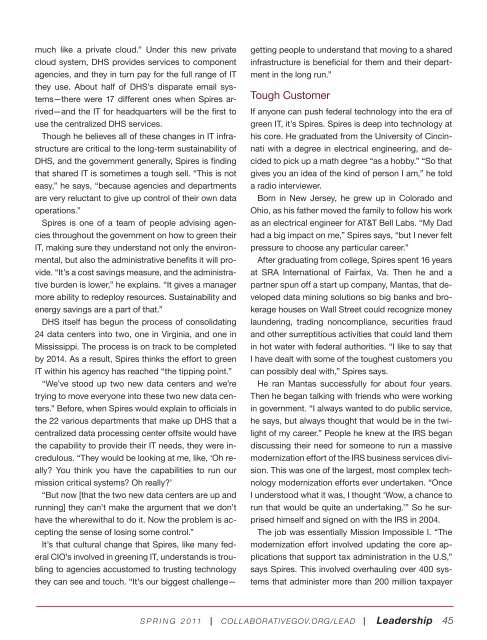Government's Sustainability Moment - CGI Initiative for Collaborative ...
Government's Sustainability Moment - CGI Initiative for Collaborative ...
Government's Sustainability Moment - CGI Initiative for Collaborative ...
Create successful ePaper yourself
Turn your PDF publications into a flip-book with our unique Google optimized e-Paper software.
much like a private cloud.” Under this new privatecloud system, DHS provides services to componentagencies, and they in turn pay <strong>for</strong> the full range of ITthey use. About half of DHS’s disparate email systems—therewere 17 different ones when Spires arrived—andthe IT <strong>for</strong> headquarters will be the first touse the centralized DHS services.Though he believes all of these changes in IT infrastructureare critical to the long-term sustainability ofDHS, and the government generally, Spires is findingthat shared IT is sometimes a tough sell. “This is noteasy,” he says, “because agencies and departmentsare very reluctant to give up control of their own dataoperations.”Spires is one of a team of people advising agenciesthroughout the government on how to green theirIT, making sure they understand not only the environmental,but also the administrative benefits it will provide.“It’s a cost savings measure, and the administrativeburden is lower,” he explains. “It gives a managermore ability to redeploy resources. <strong>Sustainability</strong> andenergy savings are a part of that.”DHS itself has begun the process of consolidating24 data centers into two, one in Virginia, and one inMississippi. The process is on track to be completedby 2014. As a result, Spires thinks the ef<strong>for</strong>t to greenIT within his agency has reached “the tipping point.”“We’ve stood up two new data centers and we’retrying to move everyone into these two new data centers.”Be<strong>for</strong>e, when Spires would explain to officials inthe 22 various departments that make up DHS that acentralized data processing center offsite would havethe capability to provide their IT needs, they were incredulous.“They would be looking at me, like, ‘Oh really?You think you have the capabilities to run ourmission critical systems? Oh really?’“But now [that the two new data centers are up andrunning] they can’t make the argument that we don’thave the wherewithal to do it. Now the problem is acceptingthe sense of losing some control.”It’s that cultural change that Spires, like many federalCIO’s involved in greening IT, understands is troublingto agencies accustomed to trusting technologythey can see and touch. “It’s our biggest challenge—getting people to understand that moving to a sharedinfrastructure is beneficial <strong>for</strong> them and their departmentin the long run.”Tough CustomerIf anyone can push federal technology into the era ofgreen IT, it’s Spires. Spires is deep into technology athis core. He graduated from the University of Cincinnatiwith a degree in electrical engineering, and decidedto pick up a math degree “as a hobby.” “So thatgives you an idea of the kind of person I am,” he tolda radio interviewer.Born in New Jersey, he grew up in Colorado andOhio, as his father moved the family to follow his workas an electrical engineer <strong>for</strong> AT&T Bell Labs. “My Dadhad a big impact on me,” Spires says, “but I never feltpressure to choose any particular career.”After graduating from college, Spires spent 16 yearsat SRA International of Fairfax, Va. Then he and apartner spun off a start up company, Mantas, that developeddata mining solutions so big banks and brokeragehouses on Wall Street could recognize moneylaundering, trading noncompliance, securities fraudand other surreptitious activities that could land themin hot water with federal authorities. “I like to say thatI have dealt with some of the toughest customers youcan possibly deal with,” Spires says.He ran Mantas successfully <strong>for</strong> about four years.Then he began talking with friends who were workingin government. “I always wanted to do public service,he says, but always thought that would be in the twilightof my career.” People he knew at the IRS begandiscussing their need <strong>for</strong> someone to run a massivemodernization ef<strong>for</strong>t of the IRS business services division.This was one of the largest, most complex technologymodernization ef<strong>for</strong>ts ever undertaken. “OnceI understood what it was, I thought ‘Wow, a chance torun that would be quite an undertaking.’” So he surprisedhimself and signed on with the IRS in 2004.The job was essentially Mission Impossible I. “Themodernization ef<strong>for</strong>t involved updating the core applicationsthat support tax administration in the U.S,”says Spires. This involved overhauling over 400 systemsthat administer more than 200 million taxpayerS P R I N G 2 0 11 | COLL ABOR ATIVEGOV.ORG/LE AD | Leadership 45


